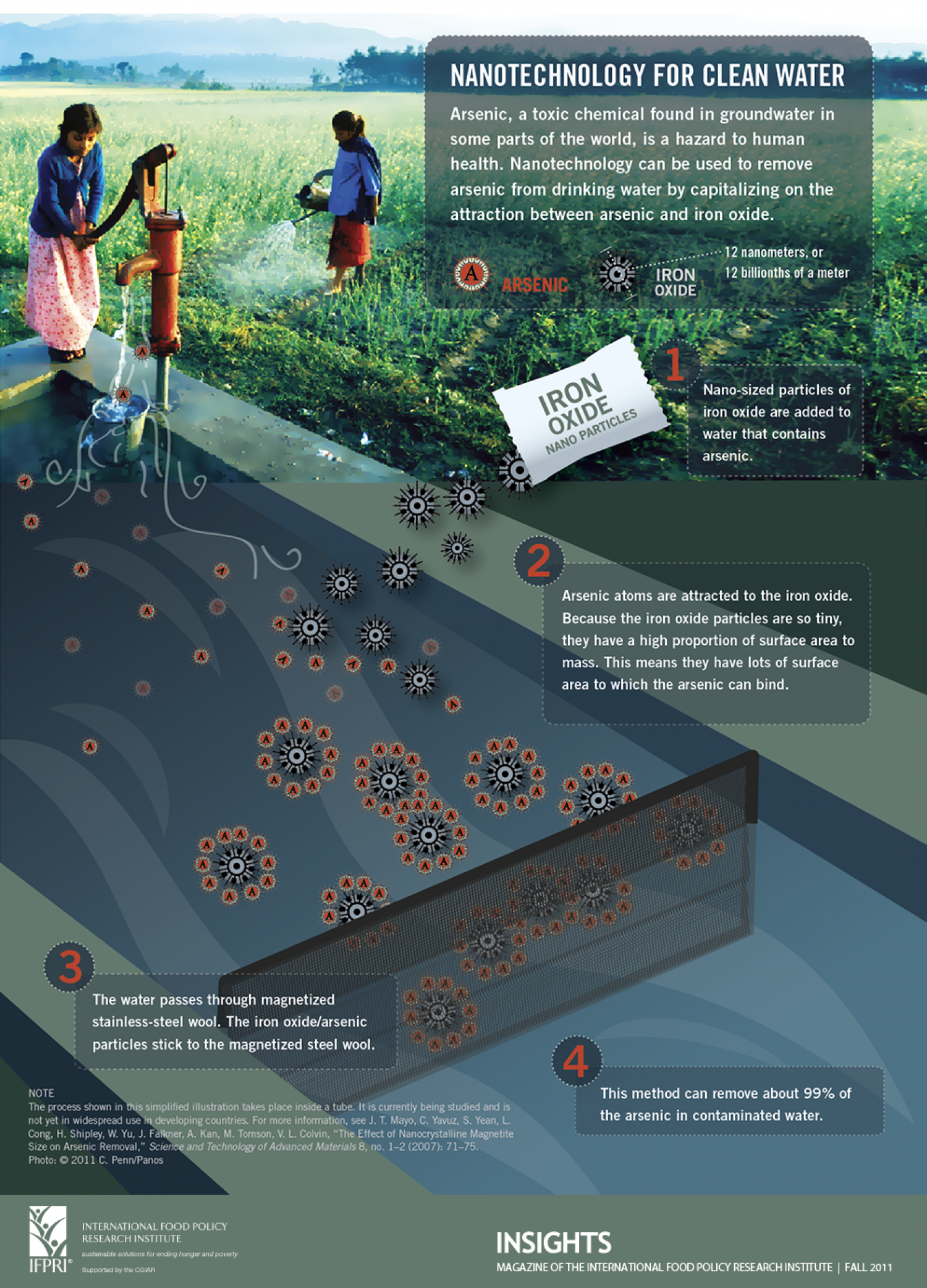
Nanotechnology for Clean Water
NANOTECHNOLOGY FOR CLEAN WATER Arsenic, a toxic chemical found in groundwater in some parts of the world, is a hazard to human health. Nanotechnology can be used to remove arsenic from drinking water by capitalizing on the attraction between arsenic and iron oxide. 12 nanometers, or 12 billionths of a meter ARŞENIC IRON OXIDE IRON OXIDE Nano-sized particles of iron oxide are added to water that contains NANO PARTICLES arsenic. ...* (2. Arsenic atoms are attracted to the iron oxide. A Because the iron oxide particles are so tiny, they have a high proportion of surface area to mass. This means they have lots of surface area to which the arsenic can bind. AA A A (3) The water passes through magnetized stainless-steel wool. The iron oxide/arsenic particles stick to the magnetized steel wool. 4. NOTE This method can remove about 99% of The process shown in this simplified illustration takes place inside a tube. It is currently being studied and is not yet in widespread use in developing countries. For more information, see J. T. Mayo, C. Yavuz, S. Yean, L. Cong, H. Shipley, W. Yu, J. Falkner, A. Kan, M. Tomson, V. L. Colvin, "The Effect of Nanocrystalline Magnetite Size on Arsenic Removal," Science and Technology of Advanced Materials 8, no. 1-2 (2007): 71-75. the arsenic in contaminated water. Photo: © 2011 C. Penn/Panos INTERNATIONAL FOOD POLICY INSIGHTS RESEARCH INSTITUTE sustainable solutions for ending hungar and poverty IFPRI" MAGAZINE OF THE INTERNATIONAL FOOD POLICY RESEARCH INSTITUTE | FALL 2011 Supported by the CGIAR NANOTECHNOLOGY FOR CLEAN WATER Arsenic, a toxic chemical found in groundwater in some parts of the world, is a hazard to human health. Nanotechnology can be used to remove arsenic from drinking water by capitalizing on the attraction between arsenic and iron oxide. 12 nanometers, or 12 billionths of a meter ARŞENIC IRON OXIDE IRON OXIDE Nano-sized particles of iron oxide are added to water that contains NANO PARTICLES arsenic. ...* (2. Arsenic atoms are attracted to the iron oxide. A Because the iron oxide particles are so tiny, they have a high proportion of surface area to mass. This means they have lots of surface area to which the arsenic can bind. AA A A (3) The water passes through magnetized stainless-steel wool. The iron oxide/arsenic particles stick to the magnetized steel wool. 4. NOTE This method can remove about 99% of The process shown in this simplified illustration takes place inside a tube. It is currently being studied and is not yet in widespread use in developing countries. For more information, see J. T. Mayo, C. Yavuz, S. Yean, L. Cong, H. Shipley, W. Yu, J. Falkner, A. Kan, M. Tomson, V. L. Colvin, "The Effect of Nanocrystalline Magnetite Size on Arsenic Removal," Science and Technology of Advanced Materials 8, no. 1-2 (2007): 71-75. the arsenic in contaminated water. Photo: © 2011 C. Penn/Panos INTERNATIONAL FOOD POLICY INSIGHTS RESEARCH INSTITUTE sustainable solutions for ending hungar and poverty IFPRI" MAGAZINE OF THE INTERNATIONAL FOOD POLICY RESEARCH INSTITUTE | FALL 2011 Supported by the CGIAR
Nanotechnology for Clean Water
Source
http://insig...all-world/Category
ScienceGet a Quote











